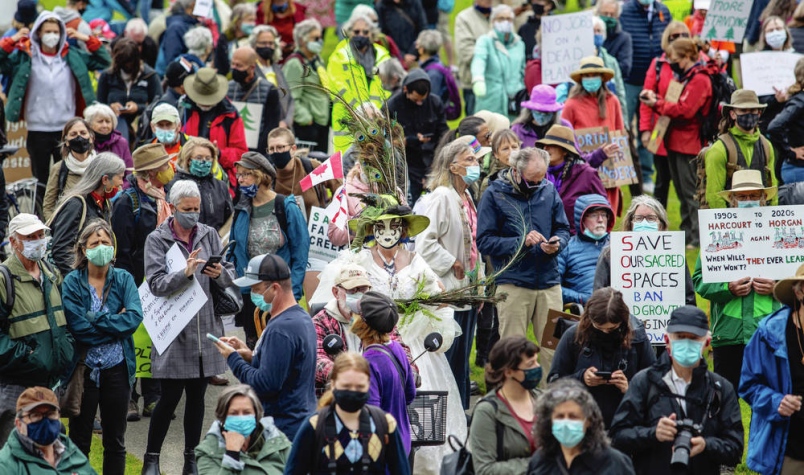Courtesy of the Times Colonist
Photo: Activists battling old growth-logging demonstrate in front of the B.C. legislature on June 11. DARREN STONE, TIMES COLONIST
The new ‘War in the Woods’ to protect old-growth forest in Fairy Creek and far beyond raises an important issue that has been neglected. By what right are those trees being cut? Who gets to decide?
In some ways, the easiest answer is “not us,” meaning not the settlers who came to this land within the past 200 years or so. We came to a land that was already occupied by a population of Indigenous people estimated to have been in the range of 200,000 to one million people, according to the First Nations Health Authority, although the population had been massively reduced by a smallpox epidemic that arrived in B.C. around 1780.
Yet the European-style state that was created here claims state ownership of 94 per cent of B.C. as “Crown land,” with five per cent in private hands and one per cent federally owned, according to the Land Title and Survey Authority of British Columbia. Meanwhile, the B.C. Treaty Commission notes “Indian reserves cover just 0.4 per cent of the B.C. land base.”
This, of course, conveniently ignores the fact that, with few exceptions, none of this land was legally purchased from, or ceded by, the hundreds of Indigenous bands and tribes that actually lived on and drew sustenance from the land. In fact, 95 per cent of B.C. is unceded, according to “Pulling Together,” a guide for Indigenization of post-secondary institutions from BCCampus.
Indeed, in 1997, the Supreme Court of Canada found that aboriginal title still exists in B.C. and that “aboriginal title is a right to the land itself — not just the right to hunt, fish and gather.” Unsurprisingly, overlapping Indigenous land claims cover more than 100 per cent of B.C., the Canadian Encyclopedia notes.
In an interview with CTV News in February 2020, Kim Stanton, a lawyer at Goldblatt Partners LLP who specializes in Aboriginal law, noted that because so much of B.C. was never ceded, the imposition of the Indian Act was illegitimate and thus while “Canada and B.C. assume that they have jurisdiction … they never legally got it.”
So by what right is the B.C. government granting any kind of logging, mining or other rights to private companies for lands that the B.C. government does not legally own? And if the B.C. government does not legally own the land, then what right do these companies have to log or mine or otherwise use the land, unless they have agreements with the First Nations that hold Aboriginal title? But then, who should they have an agreement with?
In both the Fairy Creek and the earlier Wet’suwet’en case (a dispute over the Coastal GasLink pipeline), hereditary leaders and elected leaders have been in disagreement. Stanton notes the law of the hereditary chiefs “is the law that pre-exists colonization in the territory,” and their “authority is with respect to all of their ancestral lands.”
Meanwhile, the elected band council is a colonial imposition under the Indian Act, not part of the traditional governing mechanism of First Nations. According to Pam Palmater, an Indigenous lawyer and the chair in Indigenous governance at Ryerson University, in an interview with CTV’s Power Play in February 2020, the elected councils “don’t have the authority under the Indian Act to make decisions on traditional territory,” only on the reserve lands. And anyway, Stanton suggests the Indian Act is illegitimate in B.C.
Missing in all this, of course, are the rights of the rest of humanity, of future generations and of nature itself.
Does not the rest of humanity have an interest in the forests here, just as — many would argue — people outside Brazil have an interest in not seeing the Amazon destroyed?
Do people in B.C., and humanity as a whole, not have the right to a healthy environment, which must surely include intact and healthy ecosystems?
Finally, what about the rights of nature, which we are slowly beginning to recognize. Given the growing recognition of the benefits of stewardship of traditional lands by Indigenous people, guided by traditional values, would we all be better off if we gave the land and waters personhood, represented and safeguarded by traditional Indigenous leadership, as is beginning to happen in Aotearoa, New Zealand?
Dr. Trevor Hancock is a retired professor and senior scholar at the University of Victoria’s School of Public Health and Social Policy.
